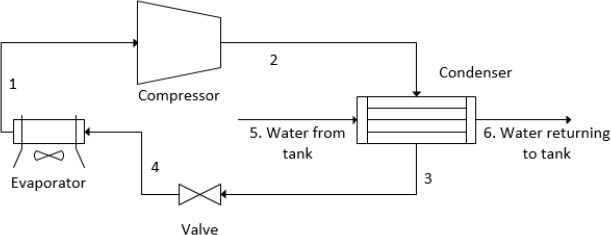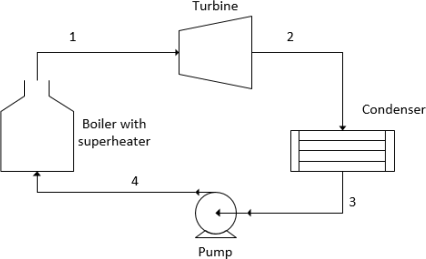ENGG1500 Engineering Thermodynamics Semester Two Final Examinations, 2019
Hello, dear friend, you can consult us at any time if you have any questions, add WeChat: daixieit
School of Chemical Engineering
EXAMINATION
Semester Two Final Examinations, 2019
ENGG1500 Engineering Thermodynamics
QUESTION 1 (10 marks)
A rigid vessel with a volume of 0.1 m3 contains R-134a at 1600 kPa and 60 oC. It is then cooled until a temperature of 48 oC is reached.
(a) (2 marks) What is the mass of R-134a in the vessel?
(b) (8 marks) How much heat, in kJ, has been removed during the cooling?.{If you could not answer part a, assume the vessel contains 5 kg of R-134a}
QUESTION 2 (8.5 marks)
A nozzle is used to accelerate steam. The steam enters at 1.6 MPa and 225 oC. It leaves at 200 oC and 1.0 MPa. Heat is transferred from the nozzle to the surroundings at a rate of 50 kW . The flowrate of steam is 11 kg/s and the steam has a velocity of 30 m/s at the inlet to the nozzle.
(a) (6.5 marks) What is the outlet velocity, in m/s, for the steam?
(b) (2 marks) What is the cross sectional area of the nozzle inlet (in cm2)?
QUESTION 3 (10.5 marks)
A stream of methane is being compressed. It enters the compressor at 30 oC and 2 bar. At the outlet, only the temperature can be measured and it is 70 oC. The flowrate of methane is 0.5 kg/s.
(a) (4.5 marks) Assuming the compressor is isentropic, what is the outlet pressure (in bar)?
(b) (4 marks) What is the rate of shaft work, in kW, required for this compressor?
(c) (2 marks) In reality, will the pressure be higher or lower than the value calculated in part a? Explain in a few sentences. You can use equations or diagrams if that helps your explanation.
QUESTION 4 (12.5 marks)
A large aquarium has a wide range of large tanks simulating different marine environments, from tropical to artic. Each has to be kept within a particular temperature range for the marine life to thrive. On top of this, the city that the aquarium is located in has a large variation in temperatures between winter and summer, such that the same tank may need to be heated in winter or cooled in summer. To achieve this, the aquarium uses a reverse cycle vapour-liquid system to cool or heat as required.
This question looks at when a vapour-compression cycle is operating as a heat pump at a particularly cold time of year. This heat pump is used for the “Pacific Islands” tank which is maintained at 27 oC. The condenser on the heat pump exchanges heat with a stream of water circulated from, and back to, the tank. This water comes from the tank at 27 oC and returns to the aquarium at 29 oC after being heated in the condenser. The condenser transfers 150 kW of heat to the water.
The heat pump uses R-134a. The condenser operates at 950 kPa and the evaporator operates at 160 kPa. The R-134a enters the compressor (point 1) as a saturated vapour and leaves the compressor (point 2) at 60 oC. Outside, where the evaporator is located, is at 0 oC.

In each part below number streams as per the diagram above so that your working is easy to follow.
(a) (5 marks) What flowrate of refrigerant, in kg/s, is required to achieve the 150 kW of heating required?
(b) (3.5 marks) What is the rate of shaft work required, in kW, for the compressor? What is the COP of the heat pump? {if you could not answer part a, assume the flowrate is 0.5 kg/s}
(c) (2 marks) The “Mid Atlantic” tank is maintained at 20 oC and requires heating in winter too. Would you expect the heat pump for this tank to have a higher or lower COP? Explain in a few sentences. You can use equations or diagrams if that helps your explanation.
(d) (2 marks) Draw a P-h diagram of this process. Show the vapour-liquid envelope, the direction of flow, and heat and work flow into/out of the cycle. Label points with the same numbers as above.
QUESTION 5 (16.5 marks)
You have been asked to measure the performance of an existing power station. The power station uses a steam power cycle with superheating which follows the flowsheet below.
Across the flowsheet the following properties have been measured. The numbers below correspond to the point on the flowsheet. The cycle has a flowrate of 15 kg/s of water.
1. 12.5 MPa and 700 oC
2. 50 kPa and 100 oC
3. No instruments in place to measure temperature and pressure.
4. No instruments in place to measure temperature and pressure.

In each part below number streams as per the diagram above so that your working is easy to follow.
(a) (3.5 marks) How much shaft work, in MW, does the turbine produce? (b) (7.5 marks) What is the isentropic efficiency of the turbine?
(c) (5.5 marks) Estimate the power, in kW, required for the pump. {Note: due to the lack of data directly before/after the pump, your assumptions are especially important here}.
2023-05-20